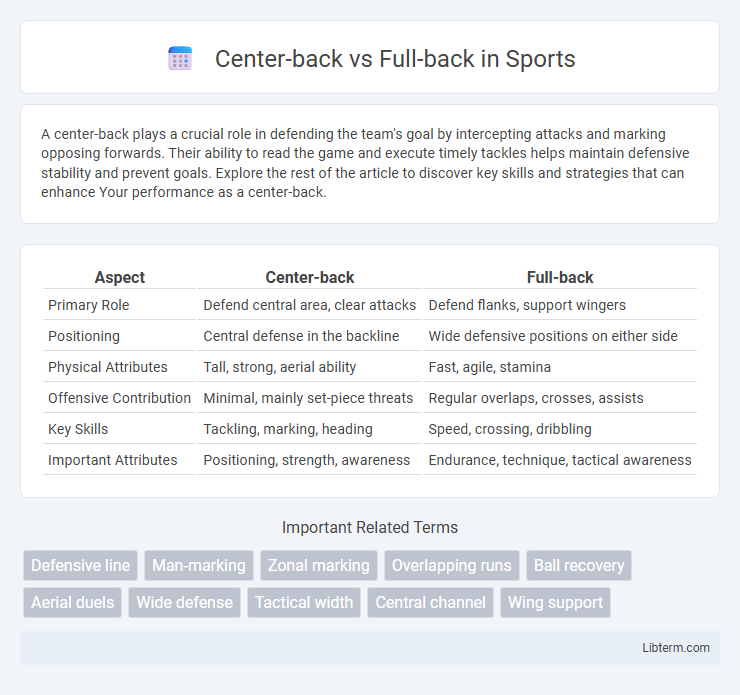A center-back plays a crucial role in defending the team's goal by intercepting attacks and marking opposing forwards. Their ability to read the game and execute timely tackles helps maintain defensive stability and prevent goals. Explore the rest of the article to discover key skills and strategies that can enhance Your performance as a center-back.
Table of Comparison
| Aspect | Center-back | Full-back |
|---|---|---|
| Primary Role | Defend central area, clear attacks | Defend flanks, support wingers |
| Positioning | Central defense in the backline | Wide defensive positions on either side |
| Physical Attributes | Tall, strong, aerial ability | Fast, agile, stamina |
| Offensive Contribution | Minimal, mainly set-piece threats | Regular overlaps, crosses, assists |
| Key Skills | Tackling, marking, heading | Speed, crossing, dribbling |
| Important Attributes | Positioning, strength, awareness | Endurance, technique, tactical awareness |
Introduction to Defensive Roles in Football
Center-backs primarily focus on marking strikers, intercepting passes, and winning aerial duels to prevent goal-scoring opportunities in football. Full-backs operate wider on the pitch, balancing defensive duties with supporting offensive plays by overlapping wingers and delivering crosses into the box. Understanding these specialized defensive roles enhances team structure and tactical flexibility in various match situations.
Defining the Center-Back Position
The center-back position in soccer is crucial for defensive stability, responsible for marking strikers, intercepting passes, and clearing aerial threats in the central defensive zone. Center-backs must possess strong tactical awareness, physical strength, and the ability to organize the defensive line. Their role contrasts with full-backs, who primarily handle wide defensive areas and support offensive plays along the flanks.
Key Responsibilities of Full-Backs
Full-backs primarily focus on defending the flanks, preventing opposition wingers from delivering crosses or cutting inside, and supporting the center-backs by maintaining defensive solidity. They often engage in overlapping runs to provide width in attack, delivering crosses into the opponent's penalty area to create scoring opportunities. Full-backs require stamina, pace, and tactical awareness to balance their dual roles in both defense and offense effectively.
Positional Differences: Center-Back vs Full-Back
Center-backs primarily operate in central defense, focusing on marking strikers, intercepting passes, and organizing the defensive line to prevent goal-scoring opportunities. Full-backs position themselves on the flanks, tasked with defending against wingers, supporting wide attacks, and providing crosses into the opponent's penalty area. Center-backs rely on aerial ability and positional awareness, while full-backs require greater speed and stamina to cover wider areas along the touchlines.
Essential Skills and Attributes for Each Role
Center-backs require exceptional aerial ability, strong tackling, and excellent positional awareness to effectively neutralize opposing strikers and organize the defensive line. Full-backs need superior pace, stamina, and crossing accuracy to support both defensive duties and attacking overlaps along the flanks. Both roles demand tactical intelligence and communication skills, but center-backs prioritize physical strength and anticipation while full-backs emphasize agility and creativity.
Tactical Importance in Modern Formations
Center-backs anchor defensive lines by maintaining positional discipline, intercepting attacks, and coordinating with midfielders to block central threats in formations like 4-3-3 and 3-5-2. Full-backs provide width and balance, supporting both defense and attack by executing overlapping runs, delivering crosses, and marking opposition wingers in systems such as 4-4-2 and 4-2-3-1. Their tactical roles adapt to high-pressing and possession-based strategies, making them essential for controlling space and transition phases in modern football.
Defensive Duties: Marking, Tackling, and Coverage
Center-backs specialize in defensive duties by marking central forwards tightly, executing strong tackles to disrupt attacks, and providing aerial coverage during set-pieces. Full-backs defend against wide attackers by marking wingers closely, performing quick tackles to regain possession, and covering the flanks to prevent crosses. Both positions require excellent spatial awareness, but center-backs focus on central defensive solidity while full-backs balance defensive duties with wide coverage.
Attacking Contributions: Overlapping vs Set-Pieces
Full-backs excel in attacking contributions through overlapping runs that stretch the opposition's defense, creating width and delivering crosses into the box, while center-backs primarily contribute offensively during set-pieces like corners and free-kicks, leveraging their height and heading ability to pose aerial threats. Overlapping full-backs often combine with wingers to overload flanks, increasing goal-scoring opportunities by providing key passes and assists. Center-backs' effectiveness in set-pieces is critical in converting dead-ball situations into goals, making them invaluable for both defensive solidity and offensive set-piece execution.
Famous Center-Backs and Full-Backs in Football History
Famous center-backs like Franz Beckenbauer, Fabio Cannavaro, and Sergio Ramos are renowned for their defensive prowess, leadership, and ability to read the game, often anchoring their teams' backlines with strength and tactical intelligence. Legendary full-backs such as Cafu, Roberto Carlos, and Dani Alves revolutionized the position by combining defensive duties with attacking support, using pace and crossing ability to influence matches dynamically. These iconic defenders have set benchmarks in football history, shaping the roles of center-backs and full-backs through their unique styles and exceptional performances.
Choosing the Right Defensive Role for Your Play Style
Center-backs excel in aerial duels, positioning, and organizing the defense, making them ideal for players who prioritize tactical awareness and physicality. Full-backs offer versatility with their ability to support attacks through overlapping runs and deliver crosses, suiting players with stamina, speed, and technical skills. Selecting the right defensive role depends on balancing defensive solidity with offensive contribution according to your play style and team formation.
Center-back Infographic

 libterm.com
libterm.com